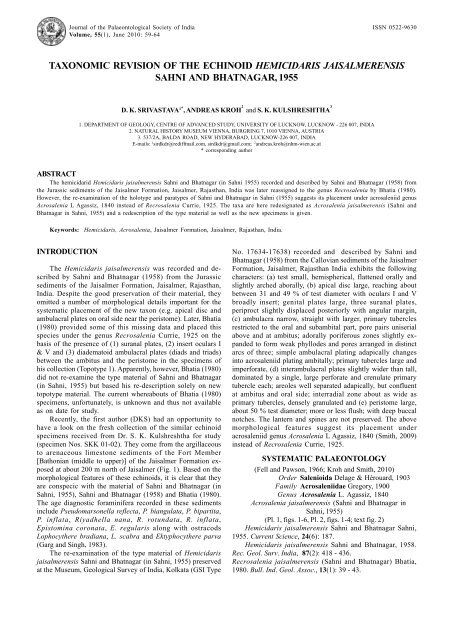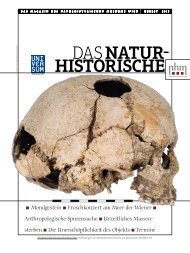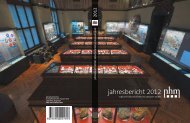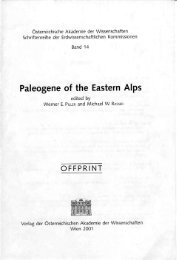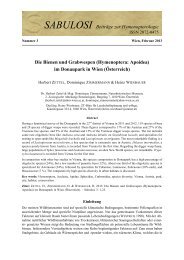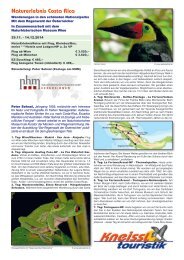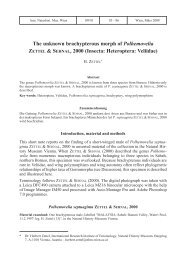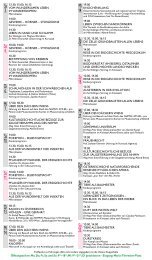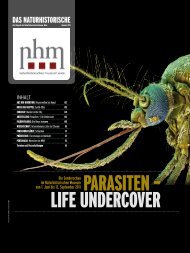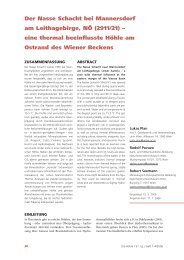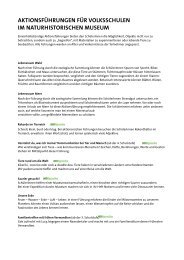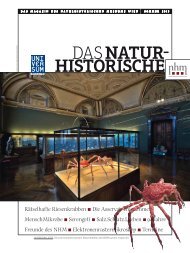taxonomic revision of the echinoid hemicidaris jaisalmerensis sahni ...
taxonomic revision of the echinoid hemicidaris jaisalmerensis sahni ...
taxonomic revision of the echinoid hemicidaris jaisalmerensis sahni ...
You also want an ePaper? Increase the reach of your titles
YUMPU automatically turns print PDFs into web optimized ePapers that Google loves.
Journal <strong>of</strong> <strong>the</strong> Palaeontological Society <strong>of</strong> India<br />
Volume, 55(1), June 2010: 59-64<br />
ISSN 0522-9630<br />
TAXONOMIC REVISION OF THE ECHINOID HEMICIDARIS JAISALMERENSIS<br />
SAHNI AND BHATNAGAR, 1955<br />
D. K. SRIVASTAVA 1* , ANDREAS KROH 2<br />
and S. K. KULSHRESHTHA 3<br />
1. DEPARTMENT OF GEOLOGY, CENTRE OF ADVANCED STUDY, UNIVERSITY OF LUCKNOW, LUCKNOW - 226 007, INDIA<br />
2. NATURAL HISTORY MUSEUM VIENNA, BURGRING 7, 1010 VIENNA, AUSTRIA<br />
3. 537/2A, BALDA ROAD, NEW HYDERABAD, LUCKNOW-226 007, INDIA<br />
E-mails: 1 sirdkdr@rediffmail.com, sirdkdr@gmail.com; 2 andreas.kroh@nhm-wien.ac.at<br />
* corresponding author<br />
ABSTRACT<br />
The hemicidarid Hemicidaris <strong>jaisalmerensis</strong> Sahni and Bhatnagar (in Sahni 1955) recorded and described by Sahni and Bhatnagar (1958) from<br />
<strong>the</strong> Jurassic sediments <strong>of</strong> <strong>the</strong> Jaisalmer Formation, Jaisalmer, Rajasthan, India was later reassigned to <strong>the</strong> genus Recrosalenia by Bhatia (1980).<br />
However, <strong>the</strong> re-examination <strong>of</strong> <strong>the</strong> holotype and paratypes <strong>of</strong> Sahni and Bhatnagar in Sahni (1955) suggests its placement under acrosaleniid genus<br />
Acrosalenia L Agassiz, 1840 instead <strong>of</strong> Recrosalenia Currie, 1925. The taxa are here redesignated as Acrosalenia <strong>jaisalmerensis</strong> (Sahni and<br />
Bhatnagar in Sahni, 1955) and a redescription <strong>of</strong> <strong>the</strong> type material as well as <strong>the</strong> new specimens is given.<br />
Keywords: Hemicidaris, Acrosalenia, Jaisalmer Formation, Jaisalmer, Rajasthan, India.<br />
INTRODUCTION<br />
The Hemicidaris <strong>jaisalmerensis</strong> was recorded and described<br />
by Sahni and Bhatnagar (1958) from <strong>the</strong> Jurassic<br />
sediments <strong>of</strong> <strong>the</strong> Jaisalmer Formation, Jaisalmer, Rajasthan,<br />
India. Despite <strong>the</strong> good preservation <strong>of</strong> <strong>the</strong>ir material, <strong>the</strong>y<br />
omitted a number <strong>of</strong> morphological details important for <strong>the</strong><br />
systematic placement <strong>of</strong> <strong>the</strong> new taxon (e.g. apical disc and<br />
ambulacral plates on oral side near <strong>the</strong> peristome). Later, Bhatia<br />
(1980) provided some <strong>of</strong> this missing data and placed this<br />
species under <strong>the</strong> genus Recrosalenia Currie, 1925 on <strong>the</strong><br />
basis <strong>of</strong> <strong>the</strong> presence <strong>of</strong> (1) suranal plates, (2) insert oculars I<br />
& V and (3) diadematoid ambulacral plates (diads and triads)<br />
between <strong>the</strong> ambitus and <strong>the</strong> peristome in <strong>the</strong> specimens <strong>of</strong><br />
his collection (Topotype 1). Apparently, however, Bhatia (1980)<br />
did not re-examine <strong>the</strong> type material <strong>of</strong> Sahni and Bhatnagar<br />
(in Sahni, 1955) but based his re-description solely on new<br />
topotype material. The current whereabouts <strong>of</strong> Bhatia (1980)<br />
specimens, unfortunately, is unknown and thus not available<br />
as on date for study.<br />
Recently, <strong>the</strong> first author (DKS) had an opportunity to<br />
have a look on <strong>the</strong> fresh collection <strong>of</strong> <strong>the</strong> similar <strong>echinoid</strong><br />
specimens received from Dr. S. K. Kulshreshtha for study<br />
(specimen Nos. SKK 01-02). They come from <strong>the</strong> argillaceous<br />
to arenaceous limestone sediments <strong>of</strong> <strong>the</strong> Fort Member<br />
[Bathonian (middle to upper)] <strong>of</strong> <strong>the</strong> Jaisalmer Formation exposed<br />
at about 200 m north <strong>of</strong> Jaisalmer (Fig. 1). Based on <strong>the</strong><br />
morphological features <strong>of</strong> <strong>the</strong>se <strong>echinoid</strong>s, it is clear that <strong>the</strong>y<br />
are conspecic with <strong>the</strong> material <strong>of</strong> Sahni and Bhatnagar (in<br />
Sahni, 1955), Sahni and Bhatnagar (1958) and Bhatia (1980).<br />
The age diagnostic foraminifera recorded in <strong>the</strong>se sediments<br />
include Pseudomarsonella reflecta, P. biangulata, P. bipartita,<br />
P. inflata, Riyadhella nana, R. rotundata, R. inflata,<br />
Epistomina coronata, E. regularis along with ostracods<br />
Lophocy<strong>the</strong>re bradiana, L. scabra and Ektyphocy<strong>the</strong>re parva<br />
(Garg and Singh, 1983).<br />
The re-examination <strong>of</strong> <strong>the</strong> type material <strong>of</strong> Hemicidaris<br />
<strong>jaisalmerensis</strong> Sahni and Bhatnagar (in Sahni, 1955) preserved<br />
at <strong>the</strong> Museum, Geological Survey <strong>of</strong> India, Kolkata (GSI Type<br />
59<br />
No. 17634-17638) recorded and described by Sahni and<br />
Bhatnagar (1958) from <strong>the</strong> Callovian sediments <strong>of</strong> <strong>the</strong> Jaisalmer<br />
Formation, Jaisalmer, Rajasthan India exhibits <strong>the</strong> following<br />
characters: (a) test small, hemispherical, flattened orally and<br />
slightly arched aborally, (b) apical disc large, reaching about<br />
between 31 and 49 % <strong>of</strong> test diameter with oculars I and V<br />
broadly insert; genital plates large, three suranal plates,<br />
periproct slightly displaced posteriorly with angular margin,<br />
(c) ambulacra narrow, straight with larger, primary tubercles<br />
restricted to <strong>the</strong> oral and subambital part, pore pairs uniserial<br />
above and at ambitus; adorally poriferous zones slightly expanded<br />
to form weak phyllodes and pores arranged in distinct<br />
arcs <strong>of</strong> three; simple ambulacral plating adapically changes<br />
into acrosaleniid plating ambitally; primary tubercles large and<br />
imperforate, (d) interambulacral plates slightly wider than tall,<br />
dominated by a single, large perforate and crenulate primary<br />
tubercle each; areoles well separated adapically, but confluent<br />
at ambitus and oral side; interradial zone about as wide as<br />
primary tubercles, densely granulated and (e) peristome large,<br />
about 50 % test diameter; more or less flush; with deep buccal<br />
notches. The lantern and spines are not preserved. The above<br />
morphological features suggest its placement under<br />
acrosaleniid genus Acrosalenia L Agassiz, 1840 (Smith, 2009)<br />
instead <strong>of</strong> Recrosalenia Currie, 1925.<br />
SYSTEMATIC PALAEONTOLOGY<br />
(Fell and Pawson, 1966; Kroh and Smith, 2010)<br />
Order Salenioida Delage & Hérouard, 1903<br />
Family Acrosaleniidae Gregory, 1900<br />
Genus Acrosalenia L. Agassiz, 1840<br />
Acrosalenia <strong>jaisalmerensis</strong> (Sahni and Bhatnagar in<br />
Sahni, 1955)<br />
(Pl. 1, figs. 1-6, Pl. 2, figs. 1-4; text fig. 2)<br />
Hemicidaris <strong>jaisalmerensis</strong> Sahni and Bhatnagar Sahni,<br />
1955. Current Science, 24(6): 187.<br />
Hemicidaris <strong>jaisalmerensis</strong> Sahni and Bhatnagar, 1958.<br />
Rec. Geol. Surv. India, 87(2): 418 - 436.<br />
Recrosalenia <strong>jaisalmerensis</strong> (Sahni and Bhatnagar) Bhatia,<br />
1980. Bull. Ind. Geol. Assoc., 13(1): 39 - 43.
60<br />
D. K. SRIVASTAVA, ANDREAS KROH AND S. K. KULSHRESHTHA<br />
Material: seven specimens (Holotype - Geological Survey<br />
<strong>of</strong> India Type No. 17634; Paratypes - Geological Survey <strong>of</strong><br />
India Type No. 17635-17638 [by designation <strong>of</strong> Sahni and<br />
Bhatnagar, 1958]; SKK 01-02 [S. K. Kulshreshtha]); preservation<br />
good.<br />
Derivation <strong>of</strong> name: The species was named after Jaisalmer,<br />
Rajasthan, India.<br />
Diagnosis: Small acrosaleniid <strong>echinoid</strong> with large<br />
hemicyclicl apical disc, oculars I and V broadly insert and three<br />
suranal plates. Enlarged ambulacral tubercles, primary tubercles<br />
restricted to <strong>the</strong> oral and subambital part <strong>of</strong> <strong>the</strong> ambulacra.<br />
High interambulacral plates. Interradial zones <strong>of</strong> <strong>the</strong><br />
interambulacra moderately wide and granular. No naked zones<br />
adapically.<br />
Description: Test small, hemispherical, with flattened oral<br />
side. Apical disc large, occupying about 36 % <strong>of</strong> test diameter;<br />
hemicyclic with oculars I and V broadly insert; genital plates<br />
large, hexagonal; three suranal plates present; periproct with<br />
angular margin, slightly displaced posteriorly. Ambulacra narrow,<br />
straight, with larger, primary tubercles restricted to <strong>the</strong><br />
oral and subambital part; dense granulation between <strong>the</strong> two<br />
rows <strong>of</strong> primary tubercles; pore pairs uniserial above and at<br />
ambitus; adorally poriferous zones slightly expanded to form<br />
1-6. Acrosalenia <strong>jaisalmerensis</strong> (Sahni and Bhatnagar in Sahni, 1955)<br />
1. Aboral view. [GSI Type No. 17637 (Paratype)]<br />
2. Oral view. [GSI Type No. 17637 (Paratype)]<br />
3. Aboral view. [SKK 01]<br />
EXPLANATION OF PLATE I<br />
(Bar represents 5.0 mm)<br />
weak phyllodes and pores arranged in distinct arcs <strong>of</strong> three;<br />
simple ambulacral plating adapically changes into acrosaleniid<br />
plating ambitally; primary tubercles large and imperforate.<br />
Interambulacral plates only slightly wider than tall, bordering<br />
6 to 7 ambulacral demiplates at <strong>the</strong> ambitus. Interambulacral<br />
plates dominated by a single, large perforate and crenulate<br />
primary tubercle each; areoles well separated adapically, but<br />
confluent at ambitus and oral side; interradial zone about as<br />
wide as primary tubercles, densely granulated. Peristome large,<br />
about 50 % <strong>of</strong> test diameter; more or less flush; with moderately<br />
deep buccal notches. Lantern and spines not preserved.<br />
Remarks: This species has been attributed to Sahni and<br />
Bhatnagar (1958) by Bhatia (1980: p. 418) based on <strong>the</strong> erroneous<br />
assumption that Hemicidaris <strong>jaisalmerensis</strong> Sahni and<br />
Bhatnagar (in Sahni, 1955), p. 187 published in June 1955 represents<br />
a nomen nudum. In contrast to Bhatia (1980: p. 418)<br />
statement, this paper does include a description and does fulfil<br />
<strong>the</strong> necessary requirements <strong>of</strong> <strong>the</strong> ICZN (1999, 4 th ed., Articles<br />
11.9, 13.1) and is thus deemed as available here.<br />
As outlined above, <strong>the</strong> original attribution to <strong>the</strong> genus<br />
Hemicidaris can be rejected because <strong>of</strong> <strong>the</strong> different apical<br />
disc, which is smaller (usually less than 25 % test diameter),<br />
dicyclic (rarely hemicyclic with a single ocular plate insert) and<br />
4. Oral view. [SKK 02]<br />
5. Lateral view. [SKK 02]<br />
6. Ambital interambulacra, detail [GSI Type No. 17634 (Holotype)]
Journal <strong>of</strong> <strong>the</strong> Palaeontological Society <strong>of</strong> India<br />
Volume, 55(1), June 2010<br />
SRIVASTAVA, KROH AND KULSHRESHTHA<br />
61<br />
Plate I
62<br />
D. K. SRIVASTAVA, ANDREAS KROH AND S. K. KULSHRESHTHA<br />
lacks suranal plates in Hemicidaris. The revised generic attribution<br />
<strong>of</strong> Bhatia (1980) to Recrosalenia likewise is unlikely,<br />
due to <strong>the</strong> differences in ambulacral (trigeminate throughout<br />
in Recrosalenia) and interambulacral plating (wide ambital<br />
interambulacral plates in Recrosalenia). According to Smith<br />
(2009) Recrosalenia is a junior synonym <strong>of</strong> Monodiadema. In<br />
this genus <strong>the</strong> apical disc is usually caduceus and far more<br />
posteriorly elongated than <strong>the</strong> present material. Additionally,<br />
<strong>the</strong> peristome is small in Monodiadema and large primary tubercles<br />
are largely missing in <strong>the</strong> oral and subambital ambulacra.<br />
The type material <strong>of</strong> Hemicidaris <strong>jaisalmerensis</strong> fit best with<br />
Acrosalenia. The subgenus Acrosalenia (Milnia), however,<br />
is characterized by its distinctly U-shaped genital plate 5 and<br />
thus can be ruled out.<br />
COMPARISON WITH OTHER ACROSALENIA<br />
SPECIES<br />
A. arabia Kier, 1972, from <strong>the</strong> Bathonian <strong>of</strong> Saudia Arabia,<br />
differs from A. <strong>jaisalmerensis</strong> by its higher number <strong>of</strong><br />
interambulacral plates, which are comparatively low and border<br />
3 to 5 ambulacral demiplates only at <strong>the</strong> ambitus. A. bowersi<br />
Kier, 1972, from <strong>the</strong> Bathonian <strong>of</strong> Saudia Arabia, differs from A.<br />
<strong>jaisalmerensis</strong> in its apical disc with 4 or more suranal plates,<br />
1-4. Acrosalenia Jaisalmerensis (Sahni and Bhatnagar in Sahni, 1955).<br />
1. Adapical ambulacrum V [GSI Type No. 17637 (Paratype)].<br />
2. Adoral ambulacrum IV [GSI Type No. 17637 (Paratype)].<br />
EXPLANATION OF PLATE II<br />
(Bar represents 2.0 mm)<br />
low interambulacral plates (bordering 3 to 4 ambulacral plates<br />
at ambitus), higher number <strong>of</strong> interambulacral plates per column<br />
and its smaller interambulacral primary tubercles adapically<br />
and at <strong>the</strong> ambitus. A. chartroni Lambert, 1904, from <strong>the</strong><br />
Hettangian <strong>of</strong> France, differs from A. <strong>jaisalmerensis</strong> in its wide<br />
granular interradial zones, numerous plates per interambulacral<br />
column and larger ambulacral tubercles. A. dhrumaensis Kier,<br />
1972, from <strong>the</strong> Bathonian <strong>of</strong> Saudia Arabia, differs from A.<br />
<strong>jaisalmerensis</strong> in its single, central suranal plate and lower<br />
interambulacral plates. A. gananensis Stefanini 1931 from <strong>the</strong><br />
Jurassic <strong>of</strong> Somalia differs in its high test, much more posteriorly<br />
elongated apical disc and presence <strong>of</strong> naked interradial zones<br />
adapically.<br />
A. hemicidaroides Wright, 1851, from <strong>the</strong> Bathonian <strong>of</strong><br />
England, differs from A. <strong>jaisalmerensis</strong> in its larger ambulacral<br />
tubercles at <strong>the</strong> ambitus and above and its slightly undulating<br />
poriferous zones adapically. A. lemoinei Lambert in Lambert<br />
and Lemoine, 1908, from <strong>the</strong> Jurassic <strong>of</strong> Madagascar is distinguished<br />
by its single suranal plate, more elongate apical disc<br />
and high number <strong>of</strong> interambulacral plates per column. A.<br />
loweana Wright, 1857, form <strong>the</strong> Bathonian <strong>of</strong> England, differs<br />
from A. <strong>jaisalmerensis</strong> in its larger ambital interambulacral primary<br />
tubercles and low number <strong>of</strong> interambulacral plates per<br />
3. Adoral ambulacrum II [GSI Type No. 17638 (Paratype)].<br />
4. Apical disc [SKK 01].
Journal <strong>of</strong> <strong>the</strong> Palaeontological Society <strong>of</strong> India<br />
Volume, 55(1), June 2010<br />
SRIVASTAVA, KROH AND KULSHRESHTHA<br />
63<br />
Plate II
64<br />
D. K. SRIVASTAVA, ANDREAS KROH AND S. K. KULSHRESHTHA<br />
column. A. marratensis Kier, 1972, from <strong>the</strong> Toarcian <strong>of</strong> Saudia<br />
Arabia, differs from A. <strong>jaisalmerensis</strong> in its well separated<br />
areoles and more posteriorly elongated apical disc. A.<br />
mathildae Lambert, 1935 from <strong>the</strong> Callovian <strong>of</strong> Poitou, France,<br />
differs in its narrow interradial zones. A. microstoma Lambert<br />
in Besairie, 1936 from <strong>the</strong> Bathonian <strong>of</strong> Madagascar differs by<br />
its much smaller peristome (only ~23 % <strong>of</strong> test diameter). A.<br />
(Metacrosalenia) quadrimiliaris Currie, 1927, from <strong>the</strong> Jurassic<br />
<strong>of</strong> Somalia and A. (Metacrosalenia) pseudocidaroides Currie,<br />
1925, from <strong>the</strong> Middle Jurassic <strong>of</strong> Somalia and Ethiopia, differs<br />
from A. <strong>jaisalmerensis</strong> in its sinuous ambulacra, larger<br />
interambulacral tubercles with deep areoles that are well separated<br />
at <strong>the</strong> ambitus, and its high interambulacral plates which<br />
border 10+ demiplates ambitally. A.? radians (Agassiz, in<br />
Agassiz & Desor, 1847), form <strong>the</strong> Callovian <strong>of</strong> France, differs<br />
by its larger ambulacral tubercles and naked interradial zones<br />
adapically. A. somaliensis Currie, 1925, from <strong>the</strong> Lower Jurassic<br />
<strong>of</strong> Somalia, differs in its single, central suranal plate and its<br />
complete lack <strong>of</strong> enlarged interambulacral tubercles adapically.<br />
A. spinosa Agassiz, 1840, from <strong>the</strong> Bathonian <strong>of</strong> Western<br />
Europe, differs from A. <strong>jaisalmerensis</strong> in its smooth apical disc<br />
and presence <strong>of</strong> a single suranal plate only.<br />
Numerous o<strong>the</strong>r nominal species <strong>of</strong> <strong>the</strong> genus have been<br />
described in <strong>the</strong> past, but are insufficiently known and/or preserved<br />
for comparison with <strong>the</strong> species discussed here.<br />
Locality: At about 200 m north <strong>of</strong> Jaisalmer, Rajasthan,<br />
India.<br />
Horizon: Fort Member, Jaisalmer Formation [Bathonian<br />
(Middle to Upper)].<br />
REPOSITORY<br />
The present collection <strong>of</strong> fossil <strong>echinoid</strong>s (described,<br />
undescribed and photographed) have been deposited in <strong>the</strong><br />
Museum, Department <strong>of</strong> Geology, Centre <strong>of</strong> Advanced Study,<br />
University <strong>of</strong> Lucknow, Lucknow - 226 007.<br />
ACKNOWLEDGEMENTS<br />
The authors are indebted to <strong>the</strong> Head, Department <strong>of</strong> Geology,<br />
Centre <strong>of</strong> Advanced Study, University <strong>of</strong> Lucknow,<br />
Lucknow for providing <strong>the</strong> facilities and encouragement. We<br />
are obliged to <strong>the</strong> Director, Curatorial Division, Geological Survey<br />
<strong>of</strong> India, Kolkata for providing <strong>the</strong> GSI Type specimens for<br />
restudy, grateful to Pr<strong>of</strong>. A. K. Jauhri, Department <strong>of</strong> Geology,<br />
Centre <strong>of</strong> Advanced Study, University <strong>of</strong> Lucknow, Lucknow<br />
for suggestions and to Shri Vijai Kumar Soni, Department <strong>of</strong><br />
Geology, Centre <strong>of</strong> Advanced Study, University <strong>of</strong> Lucknow,<br />
Lucknow for help in <strong>the</strong> preparation <strong>of</strong> <strong>the</strong> manuscript. We<br />
gratefully acknowledge financial assistance to <strong>the</strong> first author<br />
by <strong>the</strong> department <strong>of</strong> science and technology, New Delhi (letter<br />
no. SR/S4/ES: 163/2005; dated 15 th January, 2007).<br />
REFERENCES<br />
Agassiz, L. 1840. Description des Échinodermes fossiles de la Suisse;<br />
Seconde partie. Cidarides. Mémoires de la Société Helvétique des<br />
Sciences Naturelles, 4: i-iv, 1-97.<br />
Agassiz, L. & Desor, P. J. E. 1846-1847. Catalogue raisonné des<br />
espèces, des genres et des familles de la classe des échinodermes.<br />
Annales des Sciences Naturelles, Zoologie (Paris), 3(6): 305-374,<br />
pls. 15-16 (1846); 3(7): 129-168 (1847); 3(8): 5-35, 355-380 (1847).<br />
Bhatia, S. B. 1980. Taxonomic comments on Hemicidaris <strong>jaisalmerensis</strong><br />
from <strong>the</strong> Jurassic <strong>of</strong> Jaisalmer, Rajasthan, India. Bulletin Indian Geologists<br />
Association, 13(1): 39 - 43.<br />
Besairie, H. 1936. Recherches géologiques á Madagascar, I: La Géologie<br />
du Nord-Ouest. Mémoir Academy Malgache, 21: 9-259.<br />
Currie, E. D. 1925. The collection <strong>of</strong> fossils and rocks from Somaliland.<br />
Pt. 5. Jurassic and Eocene Echinoidea. Monograph Geology Department,<br />
Hunterian Museum, 1: 46-76.<br />
Currie, E. D. 1927. Jurassic and Eocene <strong>echinoid</strong>s from Somaliland.<br />
Transactions Royal Society <strong>of</strong> Edinburgh, 55: 411-441.<br />
Dave, A. and Chatterjee, T. K. 1996. Integrated foraminiferal and<br />
ammonoid biostratigraphy <strong>of</strong> Jurassic sediments in Jaisalmer basin,<br />
Rajasthan. Journal Geological Society <strong>of</strong> India, 47(4): 477-490.<br />
Fell, H. B. and Pawson, D. L. 1966. Echinacea, pp. U375-U382 In:<br />
Treatise on Invertebrate Paleontology (Eds. Moore, R.C. et al.) pt<br />
U3(2), (Echinodermata, Echinoidea), Geological Society <strong>of</strong> America<br />
Inc. and University <strong>of</strong> Kansas Press.<br />
Garg, R. and Singh, S. K. 1983. Distinctive Bathonian agglutinated<br />
foraminifera from Jaisalmer, Western Rajasthan, India. Journal <strong>of</strong><br />
<strong>the</strong> Palaeontological Society <strong>of</strong> India, 28: 118-133.<br />
ICZN (ed.) 1999. International Code <strong>of</strong> Zoological Nomenclature.<br />
Fourth Edition. International Trust for Zoological Nomenclature,<br />
London, xxix+306 pp.<br />
Kier, P. M. 1972. Tertiary and Mesozoic Echinoids <strong>of</strong> Saudi Arabia.<br />
Smithsonian Contribution <strong>of</strong> Paleobiology, 10: 1-105.<br />
Kroh, A. and Smith, A.B. 2010. The phylogeny and clasification <strong>of</strong><br />
post Palaeozoic <strong>echinoid</strong>s. Journal <strong>of</strong> Systematic Palaeontology, 8(2):<br />
147-212.<br />
Lambert, J. 1904. Note sur l'infralias de la Vendée et des deux-sèvres.<br />
IV. - Échinides. Bulletin de la Société Géologique de France, Series<br />
4, volume 3 (issue 5): 538-545.<br />
Lambert, J. 1935. Note sur les Échinides jurassiques et les oscillations<br />
du détroit poitevin. Bulletin de la Société Géologique de France,<br />
Series 5, volume 4 (issues 6-7): 523-536, pls. 26-27.<br />
Lambert, J. 1936. Nouveaux échinides fossiles de Madagascar. Annales<br />
Géologiques du Service des Mines, Madagascar, 6: 1-32, pls 1-4.<br />
Lambert, J. & Lemoine, P. 1908. Contributions a la Géologie des<br />
colonies françaises. II. Sur deux oursins nouveaux du Jurassique inférieur<br />
de Madagascar. Bulletin de la Société Géologique de France, Series<br />
4, volume 7: 476-479.<br />
Sahni, M. R. 1955. Recent Researches in <strong>the</strong> Palæontologic Division,<br />
Geological Surey <strong>of</strong> India. Current Science, 24(6): 187 - 188.<br />
Sahni, M. R. and Bhatnagar, N. C. 1958. New fossils from <strong>the</strong><br />
Jurassic rocks <strong>of</strong> Jaisalmer, Rajasthan. Records <strong>of</strong> Geological Survey<br />
<strong>of</strong> India, 87(2): 418 - 436.<br />
Smith, A. B. 2009. The Echinoid Directory [Electronic Publication].<br />
http://www.nhm.ac.uk/palaeontology/<strong>echinoid</strong> (Accessed 19th May,<br />
2009).<br />
Stefanini, G. 1931. Echinodermi, Vermi, Briozoi e Brachiopodi del<br />
Giuralias della Somalia. Palaeontographica Italica, 32: 81-130.<br />
Wright, T. 1851. On <strong>the</strong> Cidaridae <strong>of</strong> <strong>the</strong> Oolites, with a description <strong>of</strong><br />
some new species <strong>of</strong> that family. Annals and Magazine <strong>of</strong> Natural<br />
History, 2nd Series, vol. 8: 241-280.<br />
Wright, T. W. 1857-1878. Monograph on <strong>the</strong> British fossil Echinodermata<br />
<strong>of</strong> <strong>the</strong> Oolitic formations. I. Echinoidea. Palaeontographical<br />
Society Monographs, x+481 pp.<br />
Manuscript Accepted April 2010


